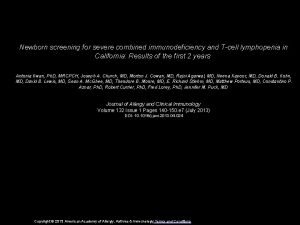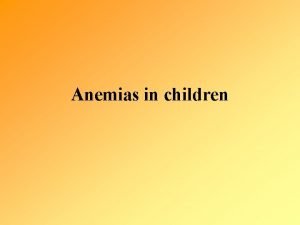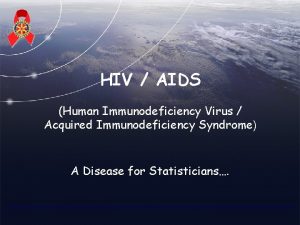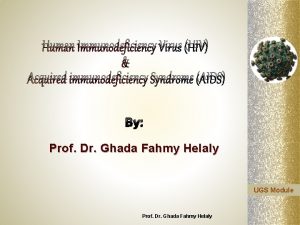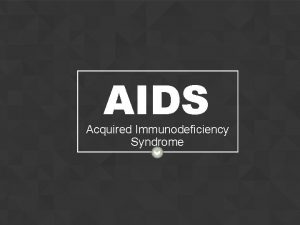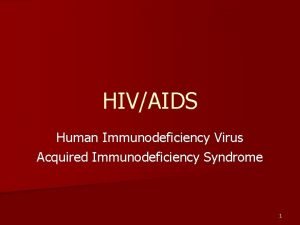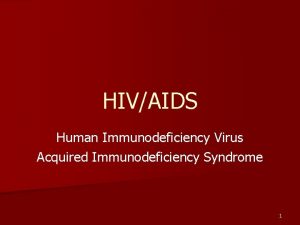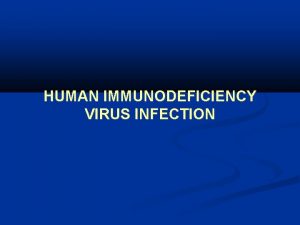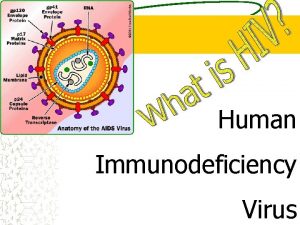AIDS Acquired Immunodeficiency Syndrome AIDS is a disease










- Slides: 10

AIDS Acquired Immunodeficiency Syndrome (AIDS) is a disease that is spread through blood and other bodily fluids. It attacks and destroys the immune system, leaving the victim unable to fight off infections. Today, almost 23 million people in sub-Saharan Africa are living with HIV/AIDS- the highest in the world!



About 23 million people across the continent have AIDS, and 1. 5 million have died. These deaths have created over 11 million orphans.

Is there a cure? Unfortunately AIDS cannot be cured. Scientists haven’t been able to find a vaccine or prevent the HIV infection. There are drugs that can slow down the progress of the disease called antiretroviral drugs (AVTs), but they are expensive and many patients can’t afford them.

EPIDEMIC Poor healthcare systems, poverty, and lack of government organization, as well as ignorance about the disease and its causes and prevention, contribute to the number of AIDS cases. The situation has gotten even worse as a result of poverty and weak educational and public health services. The epidemic now places a huge burden on the healthcare systems on countries that barely have enough resources to handle basic care. Few African countries have the resources to treat AIDS patients.

GOVERNMENT STABILITY AIDS has become an epidemic in Africa because the spread of the disease was overshadowed by the lack of stability in African governments. A country’s government stability has a huge impact on the distribution of resources to combat AIDS.

South Africa It is estimated that 1 in 5 people may be infected with AIDS, yet few have access to the AVTs. AIDS took hold in South Africa just as Apartheid was ending and the country’s focus was on stabilizing the country during the early stages of the AIDS epidemic.

Zimbabwe & Nigeria Zimbabwe has one of the highest rates of HIV/AIDS in the world. The country also has government corruption, civil unrest, and a suspicion of outside help—which has made the situation worse. Zimbabwe also has a very poor economy, meaning that the expensive AVTs are impossible for most people to afford. Even though Nigeria has oil, most Nigerians are relatively poor, and the 3 million people infected with AIDS cannot afford treatment. In the 1990 s, Nigeria’s government began to make AIDS a priority and began to focus on prevention, treatment and care. The nation still struggles, but the government is trying to educate its citizens about prevention.

AIDS in Botswana has maintained a stable democratic government since the country gained independence in 1966. As a result, Botswana has the resources to help treat AIDS patients. Botswana’s government has provided education and prevention training for its citizens. It was also the first country to offer the necessary drug therapy for free to infected people.
 What are deficiency
What are deficiency Severe combined immunodeficiency
Severe combined immunodeficiency Communicable disease and non communicable disease
Communicable disease and non communicable disease Nursing diagnosis of adrenal tumor
Nursing diagnosis of adrenal tumor Acquired immunity
Acquired immunity Aids
Aids Inherited traits and learned behaviors
Inherited traits and learned behaviors Father of modern management. *
Father of modern management. * Acquired hemolytic anemia
Acquired hemolytic anemia Inherited and acquired traits
Inherited and acquired traits Acquired dyserythropoietic anemia
Acquired dyserythropoietic anemia

